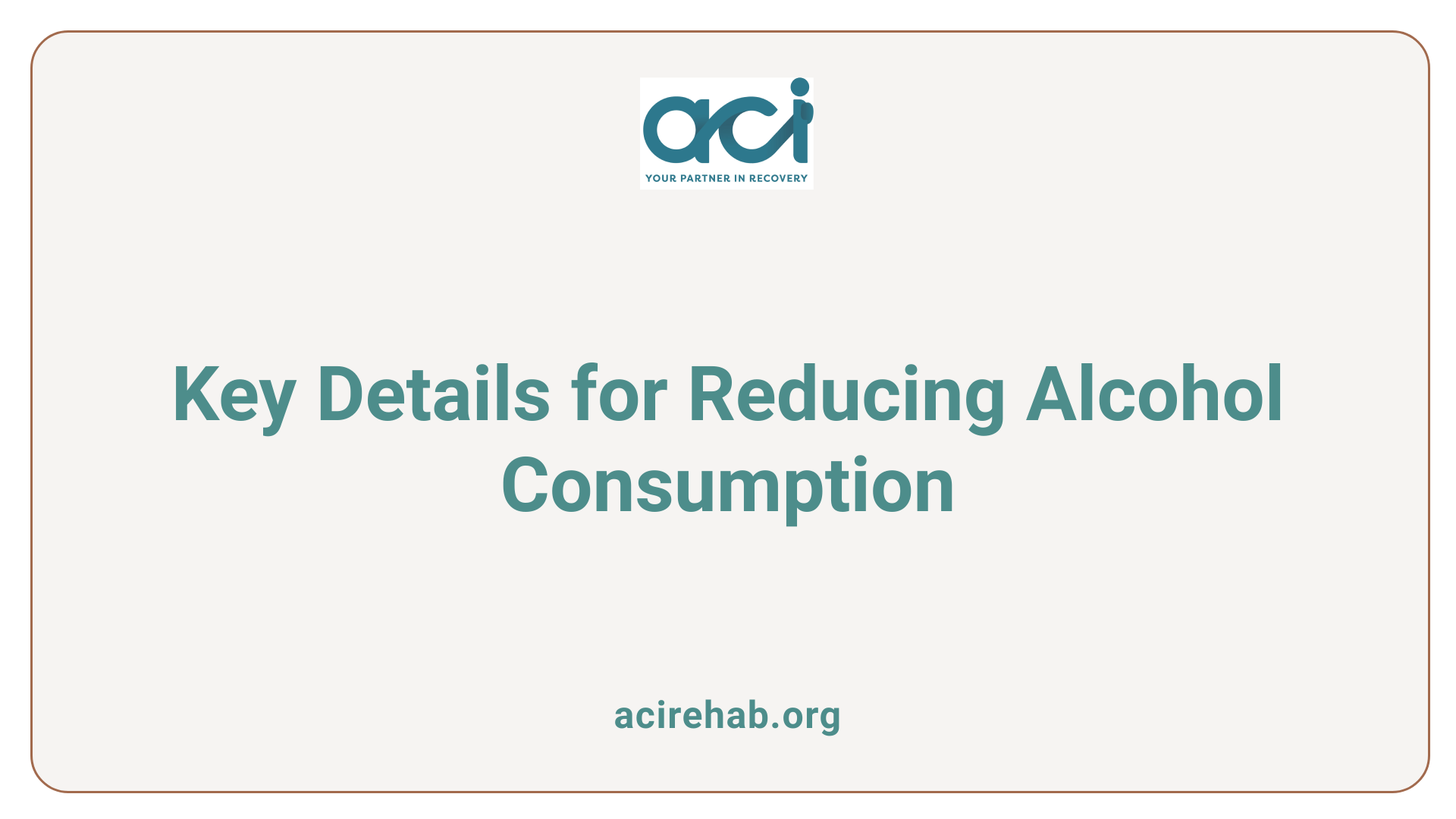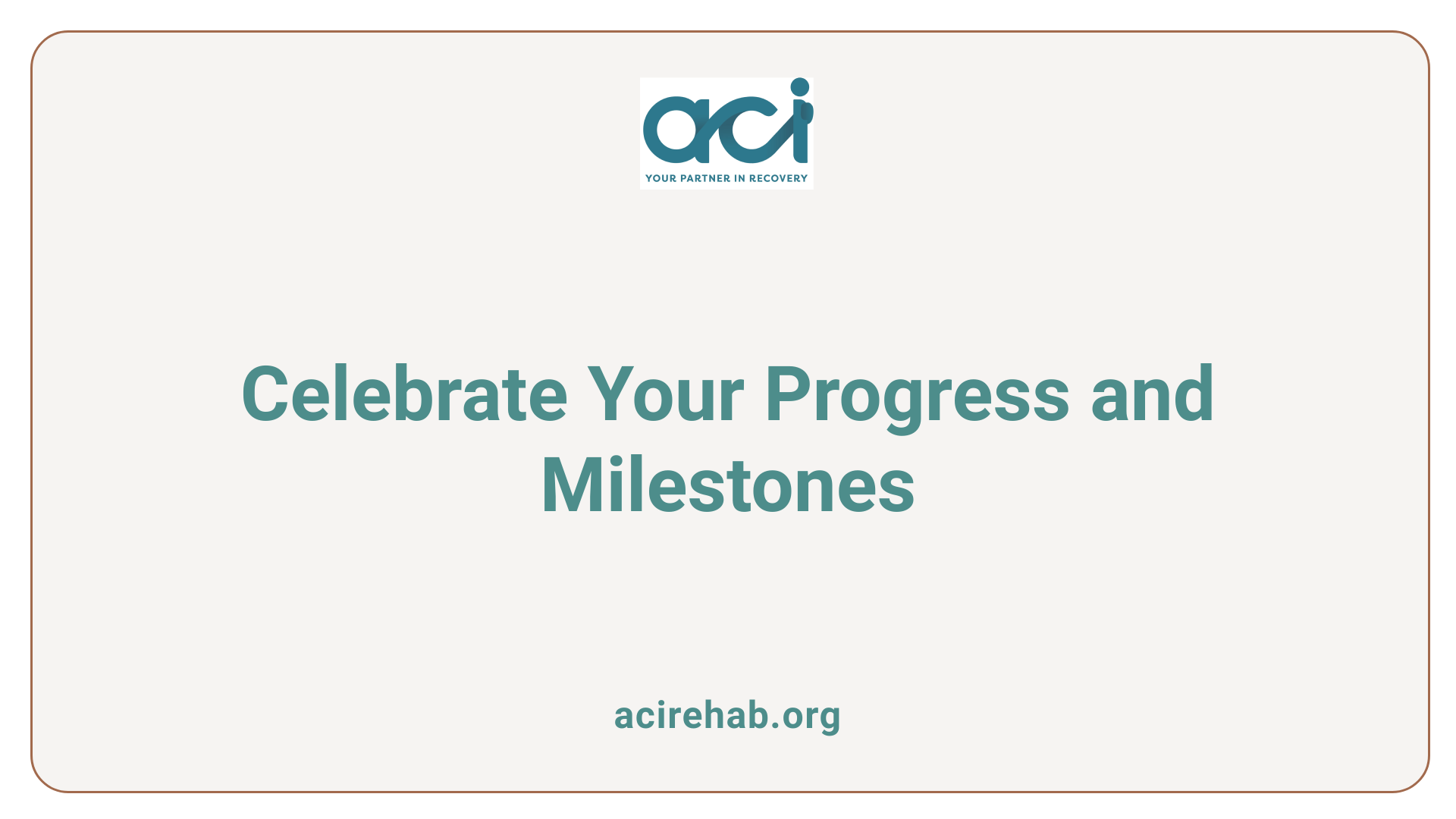Introduction
Deciding to give up alcohol is a commendable choice that promises numerous health and lifestyle benefits. Yet, the journey towards sobriety can often feel daunting. This article delivers ten actionable strategies to support you through the process, empowering you to redefine your relationship with alcohol and embrace a healthier lifestyle.
Key Facts on Quitting or Reducing Alcohol

- Recognizing motivations for quitting, like health or relationships, strengthens resolve.
- Setting realistic goals, such as limiting to one drink daily, guides consumption.
- Identifying personal triggers helps manage urges by keeping a drinking diary.
- Creating a support system, including friends and professionals, fosters accountability.
- Tracking progress through a drinking diary enhances self-awareness and decision-making.
- Removing alcohol from your environment significantly reduces temptation.
- Engaging in new activities distracts from drinking urges and promotes a fulfilling routine.
- Alternating alcoholic drinks with non-alcoholic options slows overall consumption.
- Celebrating milestones, regardless of size, reinforces positive behavior changes.
- Seeking professional guidance ensures safe withdrawal and tailored support.
1. Know Your Why

Understanding your motivations for quitting
Recognizing the reasons for reducing or quitting alcohol is vital. Common motivations may include improving health, enhancing relationships, increasing energy levels, or reducing anxiety. Understanding these personal incentives strengthens your resolve, making it easier to stick to your goals.
Keeping a reminder of your reasons
To keep your motivation alive, consider creating a visual reminder of why you want to quit. This might include a list of benefits or a vision board that highlights your aspirations. Refer to this reminder during challenging moments to help maintain focus and overcome temptations.
2. Set Realistic Goals
Importance of Setting Attainable Drinking Goals
Setting achievable drinking goals is essential for successfully modifying your alcohol consumption habits. By establishing clear limits—such as adhering to the Dietary Guidelines of no more than one drink per day for women and men over 65 or two drinks for younger men—individuals can better manage their intake and promote healthier drinking patterns. This method serves as a straightforward framework, guiding each choice contextually and fostering accountability.
Avoiding Overwhelm with Small Steps
When embarking on a journey to reduce drinking, it’s beneficial to break down goals into smaller, manageable tasks. For example, instead of focusing on quitting entirely, start with reducing drinking days or limiting drinks on specific occasions. This gradual approach helps avoid feelings of overwhelm and encourages persistence. Celebrate small wins, such as completing one alcohol-free day, to maintain motivation and reinforce progress toward the larger goal.
3. Recognize and Manage Triggers
Identifying Personal Triggers
Identifying the specific triggers that lead to the urge to drink is an essential step in managing alcohol consumption. Common triggers can include stress from work, specific social situations, or emotional states like sadness or boredom. Keeping a diary of experiences around drinking can help pinpoint these moments.
Strategies to Handle Urges
Developing strategies to manage these urges is vital. This may include practicing mindfulness techniques, engaging in physical activities, or using distraction methods like hobbies to shift focus when cravings arise. Having a clear plan for how to respond when faced with triggers can greatly enhance your ability to cope.
Importance of Avoiding Tempting Situations
Avoiding places, people, or events that encourage drinking is crucial for maintaining reduced alcohol levels. Setting boundaries around social situations and being mindful about your surroundings can significantly decrease the temptation to drink, reinforcing your commitment to moderation.
4. Develop a Support System

Building a Network of Supportive People
Creating a robust support system is a pivotal step in the journey to reduce or quit alcohol. Surrounding oneself with encouraging individuals can foster motivation and accountability. Friends and family who are aware of your goals can provide emotional support and help navigate challenges encountered along the way.
Role of Friends, Family, and Professionals
Friends often play an essential role by celebrating your successes and encouraging you during setbacks. Family support creates a safe environment to discuss struggles and share experiences. Additionally, professionals, including therapists and alcohol counselors, can offer specialized guidance to address underlying issues and create tailored strategies for recovery.
How Support Systems Aid in Recovery
Having a circle of supportive individuals not only bolsters personal motivation but also reduces feelings of isolation. Engaging in conversations about your journey can reinforce your commitment to reducing alcohol consumption, making recovery feel less overwhelming. The power of shared experiences and motivation can significantly enhance your chances of success.
5. Track Your Progress
Keeping a drinking diary
Maintaining a drinking diary is a practical method to understand your habits. This diary allows you to record not just the quantity and frequency of your alcohol consumption, but also the context in which you drink. Note the triggers or situations that prompt you to reach for a drink.
Importance of reflection and self-awareness
The act of journaling helps instill greater self-awareness about drinking behaviors. Regular reflection on your entries can reveal patterns, such as emotional triggers or social situations that lead to increased consumption. This heightened awareness is essential for identifying areas for improvement and adjusting your goals accordingly.
Reflection fosters motivation, providing insights into how reducing alcohol can lead to numerous health benefits such as better sleep, increased energy, and improved mood. By actively tracking progress, you not only reinforce your commitment to change but also celebrate each achievement, no matter how small.
6. Remove Alcohol from Your Environment
Avoid Temptation by Keeping Alcohol Out
One of the most straightforward yet effective strategies for reducing alcohol consumption is to remove it from your living space. By eliminating access to alcohol, you significantly decrease the temptation to drink—a crucial step for those beginning their journey to sobriety. This involves clearing out your home of any alcoholic beverages that might trigger cravings or provide an opportunity to drink impulsively.
Creating a Conducive Environment for Sobriety
In addition to removing alcohol, it’s essential to cultivate an environment that supports mindfulness and healthy habits. Consider stocking up on alcohol-free alternatives instead. Keep non-alcoholic beverages like sparkling water and herbal teas at hand. This not only satisfies the social aspect of holding a drink but also reinforces your commitment to sobriety.
To enhance this environment, engage in activities that promote wellness, such as inviting friends over for game nights or movie marathons that don’t revolve around drinking. Surrounding yourself with supportive people can greatly contribute to maintaining your sobriety goals. Creating a healthy, alcohol-free home not only reduces temptation but also reinforces a positive mindset towards a balanced lifestyle.
| Strategy | Objective | Additional Tips |
|---|---|---|
| Remove alcohol from home | Reduce temptation | Aim for a completely alcohol-free space |
| Stock up on non-alcoholic options | Provide alternatives | Keep favorites on hand to avoid cravings |
| Engage in healthy activities | Promote wellness | Suggest game nights, hikes, or cooking together instead |
7. Engage in New Activities
How Can New Hobbies Distract From Drinking?
Engaging in new activities can serve as an excellent distraction from the urge to drink. When individuals dedicate time and energy to hobbies or interests, they not only occupy their minds but also establish fulfilling routines that do not involve alcohol. This shift can significantly lessen the time spent contemplating drinking or acting on those impulses.
Examples of Alternative Activities
Here are some appealing alternatives to consider:
- Volunteering: Connect with your community while making a positive impact.
- Joining a Local Gym: Exercise not only boosts physical health but also enhances mental well-being.
- Taking Up a New Class: Explore subjects of interest while meeting new people.
- Baking or Cooking: Create delicious, healthy meals as an outlet for creativity and mindfulness.
- Reading: Dive into novels or self-help books to enrich your mind and offer a healthy escape.
- Outdoor Walks: Enjoy nature while improving physical health and mental clarity.
These activities offer enjoyable, healthy habits that promote a lifestyle change while supporting your goal to reduce drinking.
8. Explore Alcohol-Free Choices
Benefits of Alternating with Non-Alcoholic Drinks
Alternating alcoholic beverages with non-alcoholic drinks is a practical technique for anyone looking to cut back on alcohol. This method allows individuals to enjoy social situations without the added calories and potential health drawbacks of excessive drinking. Additionally, it helps slow down overall consumption and can make it easier to remain mindful of one’s drinking habits. By consciously spacing out drinks, it provides an opportunity to stay hydrated and reduces the temptation to drink more than intended.
Finding Joy in Alcohol-Free Alternatives
There are many enjoyable alternatives to alcoholic beverages that can enhance social experiences without compromising health goals. Options like fancy mocktails, flavored sparkling water, or alcohol-free beers and wines can provide a similar taste experience without the negative effects of alcohol. Exploring these alternatives not only satisfies the social aspect of drinking but also introduces a fun way to experiment with new flavors and maintain a vibrant social life while supporting sobriety.
9. Monitor and Celebrate Your Achievements

Reflecting on Progress
Keeping a drink diary is an essential tool in the journey to reduce alcohol consumption. It allows individuals to track their drinking habits and recognize patterns over time. By logging each drink, users develop self-awareness, which can lead to better decision-making regarding their consumption. Reflecting on this progress can reinforce the importance of setting realistic goals and adjusting them as necessary for continued personal growth.
Reinforcing Success by Acknowledging Milestones
Celebrating achievements, no matter how small, is vital for maintaining motivation in sobriety. Acknowledging milestones—such as a week, month, or year of reduced drinking—helps reinforce positive behavior changes. Each success raises confidence and reminds individuals of the benefits gained, from improved health to better relationships. By fostering a mindset of appreciation for these accomplishments, individuals set a strong foundation for sustained success.
10. Seek Professional Guidance

Consulting with Healthcare Providers
Consulting with medical professionals is essential for anyone looking to reduce or quit alcohol. Doctors can provide personalized guidance based on individual health needs, assess the level of dependence, and offer resources tailored to the patient’s situation.
Managing Withdrawal Symptoms Safely
For individuals heavily reliant on alcohol, withdrawal can be severe. Symptoms might include anxiety, shaking, and nausea. Seeking professional help ensures a safe detox process and may involve medications to ease withdrawal symptoms and improve comfort during this challenging time.
Available Treatment Options
Treatment for alcohol use disorder (AUD) varies and may include behavioral therapies, medications like naltrexone or acamprosate, and support group involvement. Programs such as Alcoholics Anonymous offer peer support, while cognitive behavioral therapy helps address thought patterns related to drinking. Engaging with these options can significantly enhance the likelihood of successful behavior change.
Effective Strategies for Quitting or Reducing Alcohol
What are effective strategies for quitting or reducing alcohol consumption?
Reducing alcohol consumption can be a challenging yet rewarding journey. Here are some effective strategies to consider:
-
Seek Professional Help: If alcohol dependency is suspected, it’s crucial to consult a doctor or join an alcohol support team. They can provide guidance on managing withdrawal symptoms and suggest effective treatment options.
-
Understand Triggers and Motivations: Recognizing what prompts the desire to drink helps in setting achievable goals for reduction or abstinence. Consider keeping a diary to track drinking habits and reflect on emotions linked to drinking.
-
Engage in Support Groups: Participation in programs such as Alcoholics Anonymous or online support communities can provide much-needed encouragement and accountability.
-
Incorporate Alcohol-Free Alternatives: Choosing non-alcoholic beverages can make social interactions easier while supporting your health. This can also satisfy the habit of holding a drink in social settings.
-
Stay Informed About Withdrawal: Awareness of potential withdrawal symptoms is vital. Adequate medical advice can assist in safely navigating the detox process, ensuring that you are prepared for any challenges along the way.
Implementing these strategies can significantly enhance your chances of successfully reducing or quitting alcohol consumption.
Successful Ways to Stop Drinking and Handle Cravings
Identifying Personal Triggers
Understanding what drives the desire to drink is essential for effective management. Triggers can be external—specific environments or certain people—or internal, such as stress or boredom. Recognizing these triggers allows individuals to develop strategies for handling urges.
Implementing Behavioral Strategies
Practical strategies are key to reducing alcohol intake. Having a clear plan can help maintain progress:
- Remove Alcohol: Keeping the home alcohol-free reduces temptation.
- Set Drinking Goals: Limit consumption based on guidelines—one drink daily for women and two for men under 65.
- Track Current Habits: Use a diary to monitor drinking patterns and identify problem areas.
Seeking Support Systems
Support from friends, family, or professionals strengthens resolve. Sharing intentions with others can build accountability. Participating in group support such as Alcoholics Anonymous can further enhance motivation and provide coping mechanisms.
Engaging in Alternative Activities
Filling time with enjoyable, non-drinking activities distracts from cravings. Consider hobbies like baking, exercising, or exploring new interests to create a fulfilling routine that doesn’t revolve around alcohol.
Utilizing Mindful Techniques
When cravings arise, practice mindfulness by acknowledging desires without acting on them. Techniques such as deep breathing can reduce anxiety and help navigate moments of temptation more effectively.
Conclusion
Incorporating these methods into daily life can significantly reduce cravings and empower individuals to manage their drinking habits effectively.
Supporting Someone with Alcohol Misuse
How can you support someone who is struggling with alcohol misuse?
Supporting someone facing challenges with alcohol misuse requires sensitivity and understanding. Initiating conversations about their drinking should be done when they are sober, as this creates a more open and constructive dialogue. It’s vital to express your concerns without labeling or judging them.
Encouraging engagement in alcohol-free activities can redirect their focus and help them discover new interests that don’t revolve around drinking. Suggesting they seek professional help, such as counseling or attending support group meetings like Alcoholics Anonymous, can be incredibly beneficial. These resources provide structured support and strategies for managing alcohol-related challenges.
Watching for signs of alcohol misuse is crucial. Advocate for healthier drinking habits by discussing the benefits of adhering to recommended limits: no more than one drink per day for women and two for men under 65. Be supportive, but also take care of yourself—seek support from groups or counselors if needed, as caregivers can also experience stress.
It’s essential to remain patient, as change is a process. Your encouragement, combined with a supportive environment, can significantly impact their journey toward healthier drinking habits.
Key Takeaway Table
| Support Strategies | Description | Benefits |
|---|---|---|
| Approach When Sober | Discuss concerns without judgment | Creates openness and reduces defensiveness |
| Suggest Alcohol-Free Activities | Encourage engagement in hobbies and interests | Helps shift focus from drinking to healthy alternatives |
| Recommend Professional Help | Counseling or support groups can provide guidance | Offers tools for coping and accountability |
| Monitor Signs of Misuse | Be aware of heavy drinking patterns | Enables proactive support and intervention |
| Care for Yourself | Seek support for your own well-being | Helps manage caregiver stress and sustain support efforts |
Conclusion
Embarking on a journey towards sobriety is inherently transformative. With the right strategies and support systems, you can successfully reduce or quit alcohol, paving the way for enhanced health, energy, and relationships. Each step you take brings you closer to a balanced and fulfilling life without alcohol’s constraints.
References
- 11 ways to curb your drinking – Harvard Health
- How to Stop Drinking Alcohol | Hazelden Betty Ford Foundation
- 10 Ideas To Help You Give Up Alcohol – Destinations for Teens
- How to Stop Drinking Alcohol: Making a Plan That Works for You
- How to Quit Drinking (or at Least Cut Back) – WebMD
- Advice for cutting down or quitting drinking alcohol
- How can you reduce or quit alcohol?
- Deciding to quit drinking alcohol Information | Mount Sinai – New York
- Getting Started With Drinking Less – CDC

